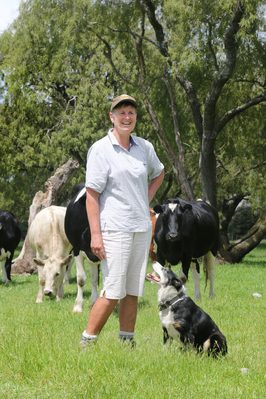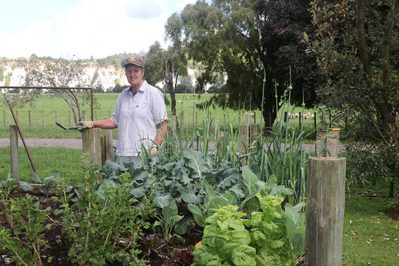Story by Russell Priest. Photos by Graeme Brown
At the ages of 53 and 57 respectively Ruth and Jim Rainey made the difficult decision to leave their beloved Kawhatau Valley hill-country farm for easier pastures 11km down the valley.
Ruth recalls vividly being told by a farming acquaintance that when you reach the age of 50 on a young man’s farm you start looking for options and you take the next best one.
This comment was based on his belief that at the age of 50 your motivation levels are still high and you feel you can still do everything however after 50 the energy and enthusiasm drops off quite quickly.
“Ours was a young man’s farm,” Ruth said. “I wasn’t ready to move because I liked where we lived among the hills and in a house with a magnificent view however Jim was ready to go.”
They got wind of a 138-hectare easy-contoured farm coming on the market further down the valley and in a flash, before it came to the attention of real estate agents, Jim was knocking at the vendors’ door successfully negotiating a contract.
Financial viability was their main concern in downsizing. They had moved from a business farming 3500 stock units to one running 1200 and had paid more for the new farm than they received from the old. Making the new farm debt free was possible only because of the contribution of the 2300su that were surplus to requirements.
Ruth is in no doubt they made the correct decision. The move has invigorated them both as well as making it easier for her on the farm. She applauds Jim’s initiative to move.
Jim became a part-time fishing guide about 20 years ago when they were farming the hill-country block and was often away from the farm from dawn to dusk and sometimes overnight. This meant Ruth’s workload on the farm increased which she didn’t mind, however her body was telling her she wasn’t getting any younger. The farm work hasn’t disappeared on the new block but it’s on a smaller scale so is more manageable.
Ruth believes farmers and particularly sheep and beef farmers find it difficult to make the decision to exit their farms so they become entrenched.
“They are apprehensive about what they are going to do when they leave,” Ruth said.
“It’s a pity more farmers don’t get involved in some form of equity or share-farming arrangement enabling them to ease themselves out more gradually.”

Farming in an inspirational environment
The main entrance to the Kawhatau Valley is near Mangaweka and across the Rangitikei River about 23km south of Taihape and 82km north north-west of Palmerston North. Dominated by spectacularly sheer white cliffs of mainly compacted mudstone and sandstone created over millions of years by the Rangitikei River as it winds its way from its source in the Kaimanawa Ranges to the sea, the area is one of the country’s best-kept secrets. This breath-taking scenery has been savoured by the Raineys for 25 years and while their physical address may have changed slightly in the last almost five years the aura of the area has not.
The Raineys’ move from their 3500su, 350ha hill-country farm occurred on March 1, 2012, and there have been few regrets. Their business was a relatively traditional hill-country operation running 2200 Highlander ewes docking between 140-150%, producing store lambs and replacement ewe hoggets. The cattle enterprise involved 70 Friesian-Hereford breeding cows mated to a Maine Anjou bull with the progeny being sold as weaners. Four-day-old herd replacement females (20-30) from the dairy industry were hand-reared. Calving was comparatively labour-intensive with cows being inspected twice a day and mothering-on of calves practiced if needed.
The new era
Being in three separate blocks involving both the main trunk railway line and the Kawhatau Valley Road makes the Raineys’ new 138ha farm somewhat disjointed. The majority of it is of flat contour however there is a 30ha hill block that is separated from the rest of the farm. Originally consisting of one paddock, it has now been divided into four and is used as the hogget block.
“It’s quite convenient,” Ruth said.
“We can put the hoggets over there and more or less forget about them.”
The Raineys now operate a breeding/finishing business. Where once their farm was too steep for cropping, Jim in particular relishes being able to grow specialist finishing crops of plantain, white clover, chicory and lucerne. A small area of swedes is grown to feed the ewe flock during its last six weeks of pregnancy, while 8ha is leased to their second son Sam for a horticultural venture.
Driven by one of her many passions Ruth, with assistance from Jim, rears about 70 mixed-sex dairy cross calves – Angus, Hereford and Charolais crosses – each year on milk powder and pellets.
“The calves are about a week old when we buy them and they are excellent animals,” Ruth said.
“Being able to rear them in new covered yards this year has been a real luxury.”
Until this year the calves were wintered twice and finished as 2-2½-year-olds at 300kg carcaseweight. To avoid the expense of the second winter the decision was made this year to sell them as stores at 15 months, freeing up land to finish more lambs over the summer.
Highlander ewe hoggets (normally 150) are bought from the Polsons, near Wanganui, annually and run on the hogget block before being mated as two-tooths. None are mated as hoggets.
Primera rams are mated to the 750 Highlander ewes producing a docking percentage of around 140.
Weaning occurs at the end of November with 60-65% of the lambs going to the works off their mothers at an average weight of a little over 17kg. The remainder are finished on the specialist finishing crops as are another 1500 bought-in lambs. Lambs by terminal sires are preferred, being bought privately or through a stock agent at around 30kg liveweight. All finishing lambs are killed by the end of May.
Diversification
Jim’s work as a part-time fishing guide is not the only means of supplementing the Raineys’ farming income. In 2001 they, in partnership with their fellow farming friends the Gorringes, established a business known as The Kawhatau Valley Walk.
For this the Raineys built a self-contained house – The Green Trout – on their farm overlooking the Kawhatau River. The three-day walk covering about 42km passes through four farms with participants accommodated in converted shearers’ quarters and The Green Trout.
The walk is now more popular with cyclists and The Green Trout has broadened its client base to include fishermen, holiday-makers and weekenders. Meeting new people, many of whom have become close friends, has greatly enriched the Raineys’ lives.
When the decision was made to sell the hill country farm the Raineys decided they were not likely to be recompensed for The Green Trout so it was sectioned off with a view to selling it separately. Some of Jim’s long-standing Australian fishing friends got wind of this and in order to avert the sale offered to buy into the business.
Today the Raineys are part-owners of The Green Trout while Ruth has maintained her managerial and cleaning role. While it is not as convenient servicing the accommodation as it once was because it is now 11km up the road, Ruth still enjoys the interaction with the clients.
Establishing pine trees is not on the priority list for many hill-country farmers, however thanks to Jim’s parents the Raineys had the foresight 25 years ago to establish 30ha of pine forest at Himatangi which will provide a valuable income stream in the future.

A strong sense of social responsibility
Brought up on a dairy farm in a family of seven children by parents with a strong social conscience, Ruth Rainey upholds this strong ethos.
“My parents taught me that the more you put into a community the more you get back and it is so true,” Ruth said.
It is no surprise therefore that the name Ruth Rainey is well known in political and community circles in the Rangitikei/Manawatu/Wanganui area and beyond. She has boundless energy and likes to make things that benefit society happen.
The executive of Manawatu/Rangitikei Federated Farmers has been a beneficiary of her energy and expertise as has also the board of Presbyterian Support Central, Women in Farming and more recently the Rangitikei District Council.
*This article appeared in Country-Wide March 2017




